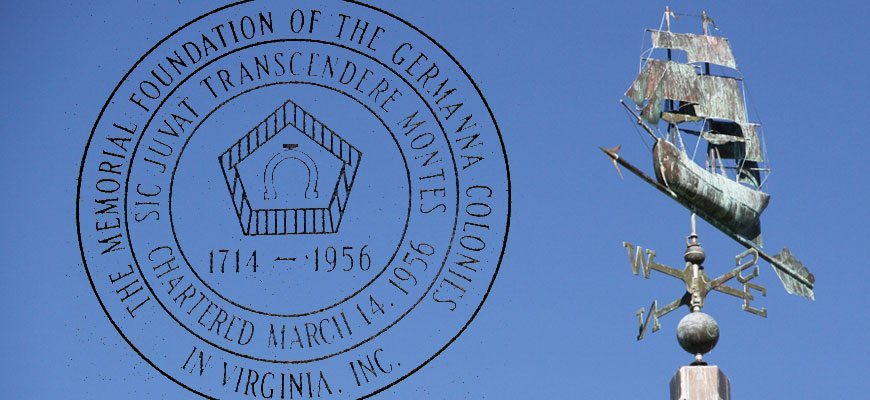The Memorial Foundation of the Germanna Colonies in Virginia, Inc. (a 501(c)(3) non-profit organization) was chartered in 1956 to preserve the heritage of the earliest organized settlements of Germans in colonial Virginia in 1714 and 1717, augmented with additional infusions of immigrants in the 1730s and 1740s.
The New Historic Germanna:
The more you look, the more you find.
Get to know the new Historic Germanna, where the more you look, the more you’ll find. We connect communities with Virginia’s past and present through historic, natural, and cultural resources.
Formerly the Germanna Foundation, we are now known as Historic Germanna to more effectively convey the depth and breadth of experiences available through this public history gem in Central Virginia. Along with our name change, we also developed a new look and logo. The logo retains the iconic script font and pentagon design representative of Fort Germanna and now takes the shape of a compass. The compass symbolizes our commitment to guide Historic Germanna outward, forging deeper connections among multiple communities and fostering a shared understanding of our intertwined histories.
Our organization’s history encompasses the lives of Indigenous peoples, English Colonists, descendants of early German immigrants, and African American communities. Through our varied programs, we serve multiple communities, including outdoor recreation and conservation, education, descendants and genealogy, archaeology, historic preservation, and tourism. Indeed, Historic Germanna provides many ways to experience little-known aspects of Virginia’s history.
At Historic Germanna, we are about uncovering and deepening our understanding of the past through archaeological digs, nature trails, tours, programs, research, exhibits, and more.
Dig deeper and find YOUR connection with Historic Germanna!
The History of Historic Germanna
In the late 1940s, R. Brawdus Martin began gathering fellow descendants, including those of Alexander Spotswood, for annual reunion picnics on land that was once part of Germanna.
In 1956, this group of families formed the Memorial Foundation of the Germanna Colonies in Virginia. Ernst Flender’s gift to purchase 270 acres of the Germanna tract restored part of the Germanna home to its modern-day stewards.
In 1969, Historic Germanna donated 100 acres of this land to the Commonwealth of Virginia for Germanna Community College.
Today Historic Germanna maintains a genealogical reference library, historical archive, exhibits and a database.
Germanna Record, with 20 volumes published since 1956, significantly contributes to Virginia’s history and genealogy.
Historic Germanna also plans annual group tours to Germany, scheduling visits to the ancestral sites of the members participating in these fascinating expert-led tours.
Our publications, other educational outreach programs, interpretive exhibits, and active participation in the historic preservation community help ensure our heritage will continue to grow with each new Germanna generation.
Click Here to read our Participant Code of Conduct
Brawdus Martin Visitor Center, Germanna Memorial Garden, and Siegen Forest
The Brawdus Martin Germanna Visitor Center was dedicated in 2000. The building was designed to call to mind the shape of Fort Germanna. A museum, Historic Germanna offices, and the Evelyn Martin genealogical and family history research library are housed in the center.
Adjoining the visitor center is a beautiful Memorial Garden with granite monuments and benches and engraved stone pavers honoring many of the immigrant families, descendants, churches, and Foundation leaders. Alexander Spotswood’s son John is buried here.
The Russell and Joan Hitt hiking trails traverse the Foundation’s 160-acre Siegen Forest for visitors to enjoy the area’s natural beauty, featuring the Rapidan River, much as the Germanna colonists would have seen it.
Fort Germanna and Enchanted Castle Site
In the fall of 2013, the Foundation acquired the site of Fort Germanna and Alexander Spotswood’s “Enchanted Castle” from the University of Mary Washington and accepted the exciting task of exploring and interpreting this important historic property.
Previous archaeological research—conducted infrequently over the past 30 years—has uncovered the ruins of the Enchanted Castle and soil markings consistent with the type of construction that described Fort Germanna.
The site, saved from development and now protected by Historic Germanna with a historic preservation easement, promises to reveal much about Germanna.
Hitt Archaeology Center (HAC)
Constructed in 2019, thanks to the generosity of descendant Russell Hitt, the Hitt Archaeology Center is located adjacent to the Visitor’s Center. It houses laboratory, research, and storage facilities. The HAC is central to the summer fieldwork and provides a space for study year-round. Archaeologists clean, catalog, and store artifacts uncovered at all the sites that Historic Germanna stewards.
The Hitt Center also provides a place for the public, students, visiting scholars, and researchers to learn more about the people and places of Historic Germanna.
Salubria
Salubria, among the oldest and finest colonial-era houses of Virginia’s Piedmont region (photo above), became the property of the Germanna Foundation through a generous gift of Laura Grayson in 2001 in order to preserve this grand Georgian-style brick mansion and its legacy.
The links between the Germanna colonies and Salubria are old and strong, as the builder of Salubria (ca. 1757), the Rev. John Thompson, married the widow of Lt. Gov. Spotswood.
Hitt Farm (Circa 1800)
On the Rappahannock River, in Fauquier County, sits a rare surviving cabin constructed in 1800 by Revolutionary War Veteran Peter Hitt and his family, along with a family cemetery.
The property was generously donated to Historic Germanna in 2017 by descendant, Russell Hitt. Since then, we have been working to stabilize and preserve the log cabin while learning more through new research.
Our long-term plan is to preserve the property and make it accessible to the public. The site has potential as a space for wellness and outdoor recreation. The historic cabin is one of the few surviving structures of its kind in the country, and its evocative presence provides a rare glimpse into the daily lives of the ordinary people who helped build a new nation.
Annual Reunion and Conference
The picnic is still a part of what is now a multi-day reunion and educational conference held the third weekend in July, bringing together Germanna descendants and families, historians, genealogists, archaeologists, anthropologists, supporters, friends, and others from around the country, and often including distant cousins from Germany.
Attendees can walk the same land as their ancestors, tour sites important to German-American history, meet new cousins and reconnect with others, learn about the early history of our country and their own families, hear about Historic Germanna’s archaeological and historic preservation activities, and enjoy the cultural landscape that is Germanna today. Annual Reunion
Membership
Annual membership helps Historic Germanna preserve the historic heritage of the Germanna colonists, their families, and descendants and ensures you stay up-to-date on Historic Germanna activities through our informative newsletter. Membership also gives you exclusive access to the Germanna database (105,000+ records). Become a Member • Donate to Germanna
Historic Germanna Newsletters
Become a member of Historic Germanna to get our newsletters mailed to your door when they first come out.
Germanna: A Family of Families
Whether you are the first or the tenth generation to have a tie to Germanna, you are part of a decades-long project that has identified more than 100,000 Americans, Canadians, and Australians who trace their family back to Germanna. Are the Germanna colonists below in your family tree?”
A Brief History of “Germanna”
In 1714, 42 German men, women, and children arrived in Virginia where Lt. Gov. Alexander Spotswood (1676-1740) settled them on the Rapidan River in a five-sided palisaded fort (named Germanna for the Germans and Queen Anne) along what was then the frontier about 20 miles west of present-day Fredericksburg. With their pastor, Henry Haeger, they formed the first German Reformed congregation in Virginia.
The Germans had come from villages near Siegen, in North Rhine Westphalia, a silver and iron producing area. Spotswood planned to use them to mine his lands, and there were hopes that silver would be found.
By 1717, iron had replaced silver as the focus of Spotswood’s mining operation. As the Siegerlanders were coming to the end of their contract, Spotswood settled a second group of Germans to add to his workforce. Coming mainly from agricultural villages in the Kraichgau area of Baden-Wurttemberg, they had expected to go to Pennsylvania. The first group acquired land in present-day Fauquier County and moved there by 1720.
With the frontier now further west, Spotswood dismantled the fort and built a mansion known as the “Enchanted Castle.” The Germanna settlement was also the site of the first courthouse for the large frontier county of Spotsylvania and was the starting point for Spotswood’s famous Knights of the Golden Horseshoe expedition over the Blue Ridge in 1716.
This second German group moved on to lands in the Robinson River Valley (now Madison County) and formed the Hebron Lutheran Church, the oldest continuously operating Lutheran Church in America. The influence and enterprising spirit of these early German colonists helped shape the Virginia colony, our young nation, and indeed can be felt throughout our nation’s history down to today.
1714 Colony from the Siegerland:
Johann Jost Albrecht, Melchior Brombach and wife Maria Elisabetha Fischbach, Jost Cuntse/Koontz and wife Anna Gertrud Reinschmidt, Philip Fischbach/Fishback and wife Elizabeth Heimbach, the Rev. Johann Heinrich Hager and wife Anna Catharina Friesenhagen, Peter/Dieter Heide/Hitt and wife Elisabeth Otterbach, Johannes Hoffman, Hans Jacob Holtzklau/Holtzclaw and wife Anna Margaretha Otterbach, Johnannes Kemper/Camper, Johann Jost Merdten/Martin, Hermann Otterbach/Utterback and wife Elisabeth Heimbach, Johann Jacob Richter/Rector and wife Anna Elisabeth Fischbach, Johannes Spielmann, Johann Heinrich Weber/Weaver and wife Anna Margarethe Huttman.
1717 Colony from the Kraichgau and the Palatinate:
Conrad Amburger/Amburgey, Andreas Ballenger, Christopher Barlur/Parlur/Barlow and wife Barbara, Matthias Beller, Balthazar Blankenbaker/Blanckenbühler and wife Anna Margaretha, Matthias Blanckenbühler /Blankenbaker and wife Anna Maria Merklin, Nicholas Blanckenbühler /Blankenbaker and wife Appollonia Käfer, Johannes/John Breuel/Briles/Broyles and wife Ursula Ruop, Cyriacus Fleischmann/Fleshman and wife Anna Barbara Schöne, Hans/John Herrensparger/Harnsberger and wife Anna Barbara, Hans Michael Holdt/Holt, Wolff Michael Käfer/Kaifer, Andreas Kerker and wife Margaretha, Hans Michael Klaar/Clore and wife Anna Barbara, Johann Michael Koch/Cook and his wife Maria Barbara Reiner, Jacob Crigler, Johannes/John Motz and wife Maria Appollonia Maubars, Hans Georg/George Majer/Moyer and wife Anna Barbara, Hans Michael Mihlekher and wife Sophia Catherina, Johann Philip Paulitz and wife Rosina Margaretha Schneider, Heinrich/Henry Schlucter, Johann Georg Sheible/Sheibley and wife Maria Eleanora Ockert, Matthäus/Matthew Schmidt/Smith and wife Regina Catherine Schlözer, Hans Michael Schmidt/Smith and wife Anna Margaretha Sauter, Hans Heinrich/Henry Schneider/Snyder and wife Anna Dorothea Schilling, Johannes/John Thoma/Thomas and wife Anna Maria Blanckenbühler, Johann George Utz and wife Anna Barbara Majer, Phillip Joseph Weber/Weaver and wife Susannah Klaar, Nicholas Jager/Yager/Yeager and wife Anna Maria Sieber, and Christopher Zimmerman and wife Anna Elisabetha Albrecht.
By 1725, more settlers had joined Germanna:
Hans Jacob Öhler/Aylor and wife Anna Magdalena Schneider, Johann Friedrich/Frederick Baumgärtner/Bumgardner, Johannes/John Becker/Baker, Harman Böhme/Beemon and wife Elizabeth, Johann/John Zimmerman/Carpenter, Wilhelm/William Zimmerman/Carpenter and wife Elizabeth, Mathias Gessler/Castler/Kastler and wife Susana Christina Schnell, Phillip Chelf, Theobald/Dewalt/David Christler/Crisler, Nicholas Christopher, Frederick Kabler/Cobbler and wife Barbara, Lawrence Greys/Crees, Johannes/John and Martin Hirsch/Deer, Conrad Delph, Mark Finks, Ludwig/Lewis Fischer/Fisher, Johannes/John Frey/Fray, Andreas Gaar/Garr and wife Eva Seidelmann, Johannes Gerhard, George Samuel Klug, George Lang/Long and wife Rebecca, Johann Paulus Lederer/Leatherer/Leathers, Francis Michael and wife Mary, John Michael and wife Frances, George Adam Raüser/Rasor/Racer and wife Margaretha Butlinger, Johann/John Rausch/Rouse and wife Mary, Henry Souther, Johann Caspar Stoever Sr., Timothy Swindle, Urban/Robert Danner/Tanner, Hans Martin Walck/Walk, Thomas Wieland/Wayland and wife Maria Barbara Seppach, Michael Willheit/Wilhoit/Wilhite and wife Anna Maria Hengsteller, Christoph Uhl/Owell/Yowell and wife Eva Gottsaurin, and Nicholas Yowell and wife Catherine, Leonard Ziegler.
In the 1730s, more Germans settled the Little Fork area (Culpeper County):
Harman Back/Bach, Harman Button, Johann Button, Johnann Just Coons/Cuntz/Koontz, Jacob Fischbach, Johann Crim/Grimm, Jacob Heimbach/Hanback, Heinrich Hoffman/Huffman, Johann and Harman Mueller/Miller, Johannes Noeh/Nay, Johann Henrich Otterbach/Utterback, John Rector, Georg Weidmann/Wayman, Tillman Wiessgerber/Whitescarver, Johannes Jung/Young.

